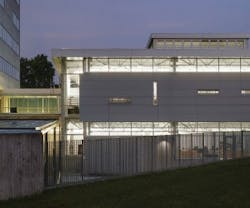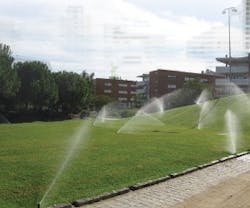Newsworthy
Avoiding Contractor Cost Discrepancies – at All Costs
Financial surprises from your contractor probably won’t be pleasant. Jim Schmid, partner in construction forensics at Grant Thornton LLP, discusses what you should do to avoid cost discrepancies with your contractor before beginning your next construction project.
Buildings: What should be done before a construction project begins to avoid cost discrepancies?
Schmid: One of the biggest issues is when an owner begins a construction project and doesn’t have complete plans and specifications – when you begin a project and haven’t nailed down the scope of work and communicated that to the contractor. The other major area is when the contract isn’t well thought out. There are some contract elements that need to be specified for the owner to be protected financially. For example, you need to have a good definition of the allowable cost of work.
Buildings: What arrangements should be in place before work begins?
Schmid: Before work begins, you must have a signed contract. This seems obvious, but I’ve seen situations where large construction projects begin and there are no signed contracts. That can be a disaster for an owner.
The project schedule should be set prior to beginning work, and it should be agreed upon between the owner and the general contractor; preferably, it would be a critical-path-based project schedule. Make sure you’ve got a contract schedule set before you begin work.
Third, the contractor should have access to the site on the date planned. Owners don’t appreciate the significance of delaying site access. The contractor will say, ‘The owner didn’t fulfill this obligation. We couldn’t get access to the site at the time the owner said we would.’ ”
Also, the owner should make sure that the project management structure is in place at the beginning of the project, and that this structure isn’t postponed. If the owner hasn’t assigned a project representative and hasn’t assigned that project representative’s staff to certain functions, you create problems that will become significant.
Buildings: What are five common ways that cost discrepancies occur?
Schmid: The first way is through owner changes in scope, or problems related to design. If design specs are late, or if they’re changed, that can cause the contractor to take advantage of the owner.
Another major area can be contractor or owner mismanagement. The owner should watch the project manager position on the part of the contractor because, if there’s turnover, that’s a red flag.
Another way is through poor contractor accounting systems, where the contractor doesn’t have the capability to track costs or bill costs appropriately – maybe there are corners cut or estimates made that aren’t accurate.
Also, there can be weak control over subcontractor bidding procedures. If you’re not getting subcontractors to bid competitively, you can lose money and not even know it.
Finally, self-performed work by a general contractor can be a source of discrepancies or disputes.
Buildings: If you have a cost discrepancy with your contractor, what should you do?
Schmid: Talk to your attorney. I also recommend that you retain some (or all) of the contractor’s pay request. It’s easier to keep your money than it is to get money back. Finally, initiate a contract compliance audit; have an auditor who is knowledgeable in construction contract auditing look at the contract requirements in terms of allowable costs and what was actually charged to the owner.
Recycling is Only Part of the Solution
Environmental sustainability can’t be achieved by just recycling or using recycled products, according to a survey of Greenbuild attendees. Respondents favored a more comprehensive approach to the environment that includes reducing consumption of products and resources.
Three-quarters of the 169 surveyed by Kimberly-Clark Professional picked “reducing consumption of resources, such as water and energy” from a list of choices about what their organizations were doing to be environmentally responsible. Sixty-three (63) percent of respondents answered “finding more ways to reduce overall consumption” as the practice that would be most beneficial to the environment; only 25 percent chose “increasing recycling or the use of recycled materials.”
Despite the low number who chose recycling as the most beneficial practice, respondents reported a high level of recycling at their organizations, with office paper, aluminum cans, plastic bottles, and cardboard being the most commonly recycled items. Toner cartridges and glass were the second most recycled items; paper towels were last.
Forty-two (42) percent of respondents said “products designed with source reduction in mind, which reduce environmental impact at every stage in a product’s life-cycle” as the No. 1 factor in choosing bath tissue and paper towels, emphasizing survey respondents’ beliefs in reduction vs. merely recycling.
New Lead-Based Paint Rule Takes Effect
Beginning on April 22, 2010, anyone receiving compensation for renovating, repairing, and painting in facilities built before 1978 that are occupied by children younger than 6 (multi-family housing, daycare centers, and schools) will be subject to the new Renovation, Repair, and Painting Rule (RRP) from the U.S. EPA. The rule’s goal is to create better lead-safe practices. Landlords who perform renovation work are also affected.
If more than 6 square feet of a painted surface is disturbed inside, or if more than 20 square feet of a painted surface is disturbed on the exterior, these new rules apply. Window replacement is also covered.
Those affected by the rule will need to:
- Apply to the EPA to be approved as a Certified Renovation Firm.
- Receive training and certification from an EPA-accredited training provider for Lead-Safe Work Practices.
- Assign a Certified Renovator for each project.
- Ensure that lead-safe work practices are used.
- Provide tenants with Renovate Right, an EPA pamphlet, prior to the start of a project.
- Maintain records documenting that the required information has been provided at each project.
Cleaning Professionals Respond to Economic Climate
With the economy in its continued slump, even the way your building is cleaned is being affected. In a recent survey by Procter & Gamble Professional, 76 percent of cleaning professionals are under pressure from upper management to keep operating costs down.
To address these issues, which resulted in budget tightening made more difficult by the H1N1 outbreak, 85 percent said they’ve adopted a “doing-more-with-less” approach to cleaning, of which 91 percent said they’re likely to continue after the economy improves.
Cleaning professionals are maximizing efficiency by using fewer staff members and choosing quality, versatile cleaning products. The survey found that the value of a cleaning product was primarily judged on quality and effectiveness (56 percent) and versatility of use (36 percent) vs. price point (5 percent) – 81 percent of respondents don’t think that having more cleaning products leads to getting the job done right. Instead, they want quality products that have multiple uses.
Staffing issues are another problem faced by cleaning professionals. Of the cleaning professionals surveyed, 68 percent report that training staff on how to properly clean is one of the biggest hurdles. High turnover due to the difficult economic times makes this even more difficult.
Community for Casino and Gaming Facility Managers Formed
Managers of casino and gaming facilities represent a small, unique portion of the facilities management profession. To unite these professionals, the International Facility Management Association (IFMA) formed the Casino and Gaming Facilities Community. Beginning with an introductory webinar that took place earlier this spring, the new community provides a network for gaming facility professionals to connect with one another and share resources through roundtables, benchmarking studies, and other continuing education opportunities. During the introductory webinar, casino and gaming facilities managers were able to draw from the experiences of their peers to tackle some of the industry’s most difficult and unique problems:
- The need for optimal HVAC systems for smoke and odor control.
- The need for clean and reliable sources of electricity.
- The 24/7 nature of the business, which means that systems requiring maintenance can’t be shut down without affecting revenue.
Dean Burwell, director of facilities for Cherokee Nation Entertainment, says that the training and staff retention problems in this industry may have to do with maintenance necessary in a 24/7 gaming facility. “This work has to be completed when business is slow; for example, from 3 a.m. to 6 a.m. of a predetermined slow day. Most employees don’t like working these hours, but it’s necessary if we want to keep facilities in good shape and equipment at peak operation.”
Grass Not So Green?
It turns out that urban green spaces may not counteract greenhouse-gas emissions after all. In fact, new research shows that these green spaces may actually increase total emissions.
While turfgrass lawns act as carbon sinks, a study by the University of California, Irvine shows that greenhouse-gas emissions from fertilizer production, mowing, leaf blowing, and other lawn management practices are greater than or equal to the amount of carbon stored by ornamental grass in parks. Emissions include nitrous oxide, which is a greenhouse gas that’s 300 times more powerful than carbon dioxide; it’s released from the soil after fertilization.
“The current trend is to count the carbon sinks and forget about the greenhouse-gas emissions,” says Amy Townsend-Small, Earth system science postdoctoral researcher and lead author of the study. “It’s unlikely for these lawns to act as net greenhouse-gas sinks because too much energy is used to maintain them.”
Survey Says: Concerns about Water Conservation are Increasing
Compared to past years, concerns about water conservation are increasing in 2010. A survey conducted by AlturaSolutions Communications asked facility managers about water conservation and found that 89 percent of the respondents believe their water-conservation concerns will intensify. Additionally, 96 percent of survey respondents believe water costs will increase in the next few years by at least 5 percent. Surprisingly, 58 percent indicated that they haven’t installed water-conserving fixtures or systems, but 72 percent of respondents say installing water-conserving fixtures and systems is important or very important.
Of the participants with water-conserving fixtures and systems in their facilities, 28 percent indicated use of high-performing toilets; 23 percent use reduced-flow faucets; 15 percent use reduced-flow showerheads; 15 percent use waterless urinal systems; and 19 percent use water-conserving landscaping systems.
New Guide Helps FDA 483 Letter Responses
FDA-regulated companies (pharmaceutical processors, blood and tissue banks, clinical laboratories, medical device manufacturers, research hospitals, and other GxP facilities) that receive public criticism warning letters must respond quickly and appropriately to FDA 483 Letters within a new 15-day window, identifying the anticipated course of action to correct the findings of an FDA inspection within a certain timeframe.
How to Avoid and Respond to Public FDA Criticisms-Form 483 Letters-for Temperature, Humidity, and other Controlled Environments, a new 10-step guide by Veriteq, gives some tips to help FDA-regulated facilities avoid warning letters, as well as an explanation about how to create a proper response after an FDA inspection produces a Form 483 Letter.
“We’ve witnessed several FDA-regulated companies that thought they were in full compliance, but weren’t when it came to environmental monitoring and documentation,” says Ken Appel, vice president of regulated markets for Veriteq.
School Districts Cut Spending Due to Rising Energy Costs
Two-thirds of school districts responding to a new “School Energy and Environment Survey” from Honeywell and Education Week research have made spending cuts or modifications as a direct result of rising energy bills. Seventy-four (74) percent of respondents also said their districts don’t have the money to pursue energy retrofit or renewable energy projects. The budgetary constraints and cutbacks, primarily in building maintenance and capital investment, are hurting efforts to boost efficiency and resolve schools’ long-term energy and financial concerns.
The online survey, which gathered information from more than 250 district administrators nationwide regarding energy management and sustainability, found that more than half of respondents have scaled back, delayed, or eliminated the possibility of energy efficiency and renewable energy projects due to the economic downturn. Additionally, 96 percent of respondents said they view energy management as important to their district’s long-term success, but one-third reported that they don’t have a strategic plan for managing energy consumption and costs.
Stricter Chile Building Codes Factor into Mitigating Damage
A large number of factors come into play when determining why and how an earthquake causes damage to buildings, but thorough and enforced structural/seismic codes that are put into effect by the government play an important role in minimizing damage.
The earthquake that hit Chile earlier this year was more than 500 times stronger than Haiti’s earthquake, yet the damage to Chile’s infrastructure was significantly less. While part of that has to do with the epicenter of the earthquake and how far below the surface it originated, part was due to the fact that building codes and past experiences allowed Chile to be prepared.
According to an article from the Daily Herald, “Chile is wealthier and infinitely better prepared, with strict building codes, robust emergency response, and a long history of handling catastrophes.”
Chile was also able to better recover from the earthquake because its strong economy allowed better materials for building and, in combination with the experience from its 9.5-Richter scale earthquake in 1960 and another in 1985, helped them develop more stringent building codes. Additionally, the Chilean government was prepared to handle the situation immediately. The day the earthquake hit, Chilean President Michelle Bachelet said that Chile had no immediate international aid needs, which is verification of Chile’s preparedness.
The final factor was not just having and enforcing seismic codes, but changing the philosophy of how the codes work. Eduardo Kausel, professor of civil and environmental engineering at MIT, told NPR: “The philosophy of earthquake codes, until relatively recently, was to prevent the loss of life … to prevent the collapse of buildings. That philosophy is now changing. In addition to protecting people, we’re now also trying to protect the buildings themselves.”
ISU’s King Pavilion Wears a Platinum Crown
Iowa State University’s new King Pavilion has been awarded LEED-NC Platinum certification by the USGBC. It’s the first higher-education building in Iowa to achieve LEED Platinum status, and one of only eight LEED-NC Platinum buildings in higher education at U.S. public institutions.
The $6.6 million, 23,735-gross-square-foot King Pavilion was added to Iowa State University’s College of Design. It features a two-story “forum” surrounded by instructional studios used by all freshmen in the college, as well as sophomores in architecture, landscape architecture, and interior design.
Out of the 69 LEED points possible, the College of Design submitted 57 points for approval and earned 53. It was awarded exemplary performance points for daylighting, water efficiency, and recycled content.
Sensors throughout the facility monitor occupancy and light levels, and turn the lights on and off. Occupancy sensors also adjust temperature and ventilation when the space isn’t occupied, making King Pavilion 45 percent more energy efficient than a code-compliant building.
“According to our energy model, King Pavilion will save a little more than $22,000 per year in energy – about $1 per square foot – over a code baseline,” says Michael Andresen, RDG Planning and Design intern architect and the LEED Accredited Professional on the project. “If you imagine ISU’s millions of square footage, and the potential of saving $1 per square foot, it begins to put into perspective the impact that sustainability can have on a larger scale.”
New Plants for the Workplace
The fashion in workplace greenery for 2010 favors lean-looking foliage – so it’s time to get rid of your Boston Ferns and get some of these instead.
According to Ambius, the five most requested workplace plants and plant varieties are:
- Dracaena Jade Jewel (a variety of the dragon tree, in striking colors).
- Spathiphyllum Viscount (a hybrid from the Peace Lily family).
- Dracaena Marginata Braid Open Weave (lush foliage and a breaded steam).
- Bromeliads (a colorful family of plants).
- Dracaena Lemon Surprise (brightly colored elliptic leaves with curled edges).
No matter their size, plants are good for your building and the people inside.
They provide a pleasant environment, tackle environmental problems in the workplace, and reduce carbon-dioxide levels that accumulate in buildings from the byproducts of heating and electrical systems.
10 Ways to Lower Landscape Water Usage
Landscape irrigation systems can account for more than 50 percent of your water consumption, so leaks or malfunctioning irrigation equipment are costly. ValleyCrest offers the following water-conservation tips for you:
- Switch from overhead irrigation to a more efficient drip system and low-application-rate nozzles, and install smart, weather-based evapotranspiration controllers that automatically adjust watering systems.
- Maintain landscapes that are harmonious with the environment by reducing green waste, nurturing healthy soils, creating wildlife habitats, and reducing stormwater runoff.
- Analyze water-usage trends and develop a plan to ensure that irrigation systems operate efficiently, irrigation runoff is reduced, and reclaimed water is used.
- Practice hydro-zoning (grouping plants with similar water requirements on the same irrigation valve to reduce over-watering).
- Install flowering perennial plants to provide a sustainable, cost-effective replacement for seasonal color changes, and consider turf conversions and plant density reductions.
- Convert fountains to planters or implement a rotation schedule for water features so fewer operate at the same time.
- Retrofit the landscape with sustainable, water-efficient landscapes and native, drought-tolerant plants.
- Increase shade by optimizing the placement and health of trees around your buildings.
- Use pruning techniques that highlight the individuality of each plant to maintain the landscape in a natural fashion.
- Explore public programs that are offered by water districts, cities, or other entities that provide rebates or credits for turf conversions and upgrades to irrigation controllers, drip conversions, and rain shutoff sensors.
Green is Best for Alachua County
Florida’s Alachua County Board of County Commissioners and its County Facilities Management Division take green seriously – they’ve developed best practices that they use when exercising green concepts. Some of their most recent projects completed with these best practices include:
Two LEED-certified fire stations have been built, including the first LEED-certified fire station in Florida. Solar hot water storage systems heat potable water and save 70 percent on energy costs. Underground cisterns each reclaim more than 60,000 gallons of water per year. Daylight reaches 75 percent of the indoor spaces in the fire stations.
A third-generation relamping project has cut down on energy consumption by 22 percent (207,585 watts) by replacing T8 32-watt lamps with T8 25-watt lamps. The top 10 energy-consuming buildings were tackled first in the relamping project. More than 31,000 bulbs were replaced, according to Charlie Jackson, Alachua County’s facilities manager. “We should see considerably more savings as we continue to surge with the implementation of energy conservation measures, including enabling staff to control lighting and shut off nonessential power-consuming devices.
Its county vehicles are hybrids; electric trucks have replaced conventional gas work vans.
Built-up roofing systems have been swapped out for SPF roofs. They reduce dependency on oil, have a very high aged R-value, reduce thermal bridging, have no VOCs, and reduce energy consumption.
An HVAC project in one building will save more than $43,000 annually. A highly efficient, state-of-the-art chiller was replaced, as well as the original cooling tower. An energy-efficient boiler and pumps will reduce gas and electricity.
Waterless urinals, tamper-resistant timer controls that shut off lavatories and showers, and dual-flush toilets have been implemented. The water-conservation system put in place is estimated to save 17 million gallons of water per year, and will pay for itself in 8.5 years.
The county has also spent time making sure that all building occupants are on board with these sustainable measures. The facilities management department communicates and educates employees about energy conservation via e-mails, press releases, community newsletters, energy-reduction bulletins, and chart boards that display the energy savings of county buildings.
And despite Alachua County’s success, it doesn’t plan to slow down anytime soon. In fact, the team plans to look next at envelope weatherization, more re-roofing projects, and solar installation. Working closely with Gainesville Regional Utilities has saved the county $77,500 in rebates, with more money on the way. The revenue from these rebates is reinvested into future energy-saving initiatives.








